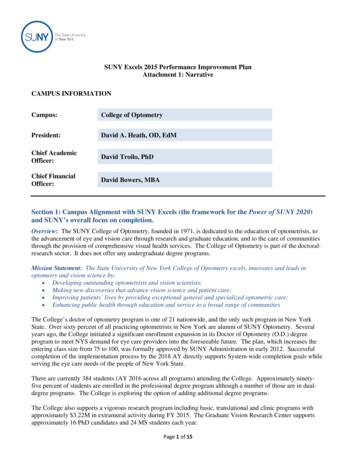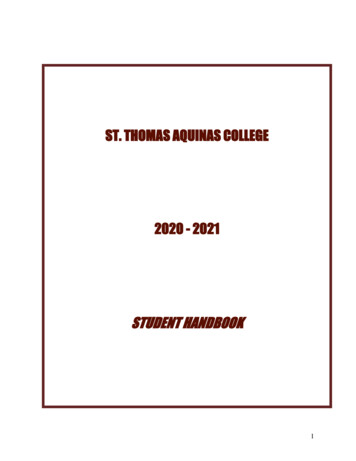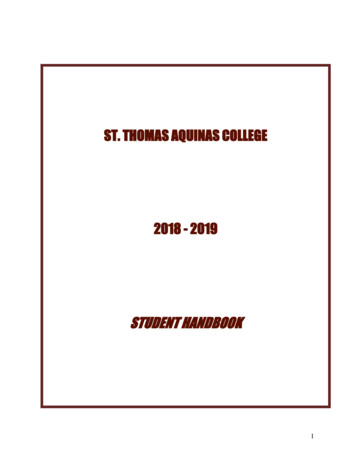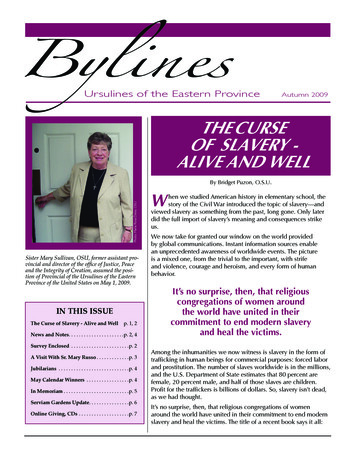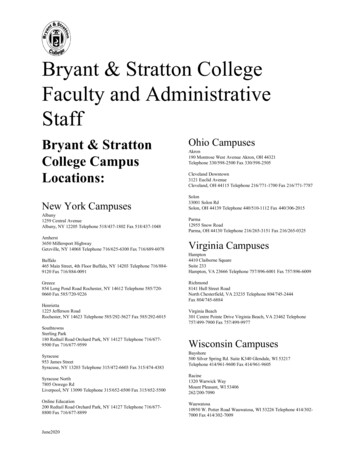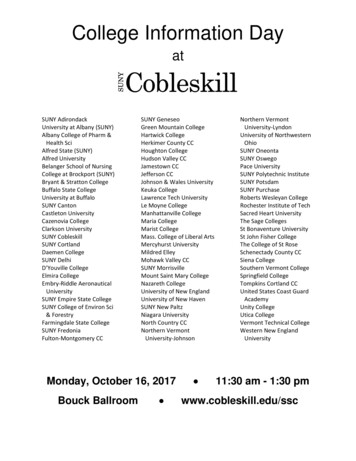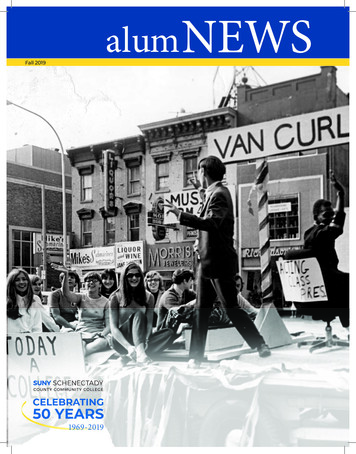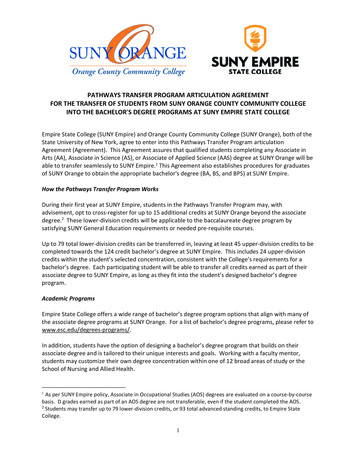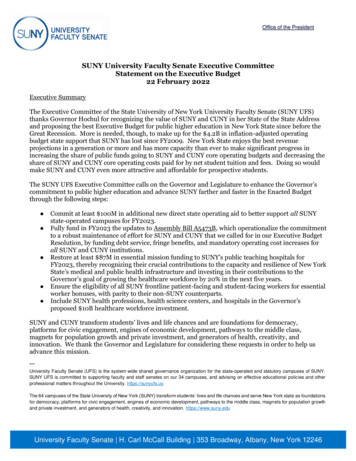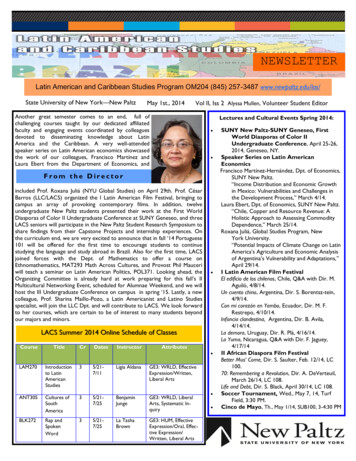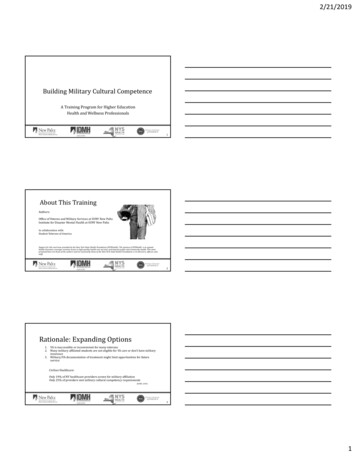
Transcription
2/21/2019Building Military Cultural CompetenceA Training Program for Higher EducationHealth and Wellness Professionals1About This TrainingAuthors:Office of Veteran and Military Services at SUNY New PaltzInstitute for Disaster Mental Health at SUNY New PaltzIn collaboration with:Student Veterans of AmericaSupport for this work was provided by the New York State Health Foundation (NYSHealth). The mission of NYSHealth is to expandhealth insurance coverage, increase access to high‐quality health care services, and improve public and community health. The viewspresented here are those of the authors and not necessarily those of the New York State Health Foundation or its directors, officers, andstaff.2Rationale: Expanding Options1.2.3.VA is inaccessible or inconvenient for many veteransMany military affiliated students are not eligible for VA care or don’t have militaryinsuranceMilitary/VA documentation of treatment might limit opportunities for futureserviceCivilian Healthcare:Only 19% of NY healthcare providers screen for military affiliationOnly 25% of providers met military cultural competency requirements(RAND, 2018)31
2/21/2019Map of VA centers and SUNYcampuses4Learning Objectives1) Understand military culture, how it differs from the culture of higher education, and the impact of these twodifferent cultures on military students2) Understand military students’ perceptions of their strengths, challenges, and their needs on campus3) Understand military students’ help‐seeking attitudes, behaviors, and decision‐making processes, includingbarriers and access points4) Understand how to use this information to build engagement and outreach strategies for military students5Impact of Military Cultural Competency toColleges & UniversitiesImproved: RecruitmentRetentionGraduationCollege ExperiencesAcademic AchievementAlumni Engagement62
2/21/2019Video: An Introduction7Understanding Military CultureLEARNING OBJECTIVE 18Why Learn About Military Culture?1.Helps you tailor programs, strategies and interventions to better serve military‐affiliatedstudents2.Helps you communicate more effectively3.Helps students feel understood and respected93
2/21/2019Defining a Military‐AffiliatedStudentService Members, Veterans and Dependents10Defining a “Service Member”Active Service Active Duty Reserve National Guard11Defining a “Veteran”The VA’s general definition is: Veteran Eligibility: For the purposes of VA health benefits andservices, a person who served in the active military service and whowas discharged or released under conditions other than dishonorableis a Veteran. Minimum Duty Requirements: Most Veterans who enlisted afterSeptember 7, 1980, or entered active duty after October 16, 1981,must have served 24 continuous months or the full period for whichthey were called to active duty in order to be eligible.124
2/21/2019Defining a “Dependent”“Dependent” is a government definition used to determine eligibility forbenefits Spouse (including same sex spouses) Children Step‐children13Defining a “Military‐AffiliatedStudent”*Those who are excluded from government eligibility definitions can still be impacted emotionally:1.2.3.4.Those with “Other than Honorable” DischargesSiblingsParentsNon‐married individuals with partners in serviceComprehensive military background policies could inform work with all of these students whomight be on your campus14U.S. Armed Forces, Reserves andNational Guard ‐ New York PopulationPopulationArmy Active Duty: 19,980Navy Active Duty: 2,184Air Force Active Duty: 327Marine Active Duty: 698Coast Guard Active Duty: 1,117Selected Reserve: 30,577Army National Guard: 10,648Air National Guard: 6,297Source: Map from the New York State Division of Military & Naval Affairs155
2/21/201916# of Military‐Affiliated SUNY Students8,000‐10,00017Military Culture186
2/21/2019Reasons for Joining To serve your country and protect your country’s liberty and freedom Travel the world Help stop terrorism College education Get a good paying job Duty and Honor for your country Family Tradition To improve yourself and learn new skills Get a career Turn your life around19Less Likely Reasons for JoiningWon’t be successful in college In recent years, there is evidence coming out that suggests that student veterans do well incollege. According to the SVA (2017), “Graduation is an opportunity for colleges anduniversities across the country to highlight and honor the success of student veterans.Our research demonstrates that when compared to their peers student veterans are more likelyto persist and graduate, to have a higher GPA and to earn degrees for in‐demand fields likebusiness, STEM, and health care.”Join the military or go to jail No longer the case20Military as a Unique CultureThe military setting has many of the core elements characterizing distinctcultures Ceremonies, Rituals, Rites, and CelebrationsSymbols, Artifacts, and Symbolic ActionsHistories, Stories, Legends, & MythsBeliefs, Values, and AttitudesRules, Taboos, Laws, & Ethical CodesLanguageTechnology(MAJ Edwards, 2016)217
2/21/2019Military Culture ‐ Values and BeliefsDisciplineDutyTeamworkSelfless ServiceLoyaltyIntegrityFreedomPersonal CourageHonorRespect(Wilson, 2008)22Branches of Services United States Army Inception: 14 June 1775United States Navy Inception: 13 October 1775United States Marine Corps Inception: 10 November 1775United States Coast Guard Inception: 4 August 1790United States Air Force Inception: 18 September 194723Military Components – Federal andStateFederalStateActive DutyReserveArmyArmyArmyNavyNavyAir ForceNaval Militia*USMCUSMCCoast GuardCoast GuardAir ForceAir ForceNational Guard*Not all states have this asset248
2/21/2019Active DutyBranchesArmyNavy Marine Corps Coast Guard Air Force Federal Entity Service Commitment of 2‐6 years Stationed all over the world Benefits Tricare Health Care Coverage: Little or no cost to service member Comprehensive Health CoverageMental HealthDrug and Alcohol TreatmentOther on base programs25Reserve Federal EntityService Commitment typically 3 or 6 year contractsCitizen WarriorOne weekend a month, two weeks a year BranchesArmy ReserveNavy ReserveMarine Corps ReserveCoast Guard ReserveAir Force Reserve Benefits (typically while activated) Tricare Health Care Coverage: must opt in and pay a premium HealthMental HealthDrug and Alcohol TreatmentOther on base programs May not be entitled to those benefits active duty and activated reservist receive Benefits while in drilling status only are significantly reduced26National Guard State Entity (subjected to the needs of both that state and federalgovernment) Service Commitment typically 3 or 6 year contracts Citizen Warrior One weekend a month, two weeks a year Benefits (typically while activated) BranchesArmy National GuardAir Force NationalGuardNaval Militia (limitedto certain states. NewYork is one of them) Tricare Health Care Coverage: must opt in and pay a premium HealthMental HealthDrug and Alcohol TreatmentOther on base programs May not be entitled to those benefits active duty and activated National Guardreceive Benefits while in drilling status only are significantly reduced279
2/21/2019MOS‐ Military OccupationalSpecialty Accounting, Budget, and Finance Arts, Communication, Media, and Design Business Administration and Operations Counseling, Social Work, and HumanServices Construction, Building, and Extraction Education and TrainingLaw Enforcement, Security, andProtective Services Health Care Practitioners Mechanic and Repair Technicians Intelligence Aviation Legal Professions and Support Services Culinary Naval and Maritime Operations Combat Arms28Basic Training/InductionInitial Entry Training/Boot Camp is an intensive residential program normally lastingseveral weeksAims to induct newly recruited military personnel into the social norms and essentialtasks of the armed forces by way of:- Confinement and Suppression- Control and Conformity- Stress and Punishment- Bonding and the Hierarchy of Esteem- Fieldcraft and Fitness- Graduation and Drop‐out 29Chain of CommandChain of Command Military‐affiliated students are used to this model of communicationMay create challenges in communicatingTaught to handle issues at the lowest levelMay prevent them from asking for helpRules around Chain of Command: Disrespecting an Officer“Jumping” the Chain of CommandFraternization3010
2/21/2019RanksEnlistedCommissioned OfficerEnlisted are the backbone of themilitary. They have specificspecialties within a military unitOfficers act as managers to theenlisted. They plan missions, giveorders, and assign tasks. Enlistedexecute those tasks.3132Military Rules/TaboosUniformed Code of Military Justice (UCMJ) 134 Articles Examples: Article 15: Nonjudicial punishment Article 91: Insubordinate conduct toward Warrant Officer, Noncommissioned Officer, or PettyOfficer (1) strikes or assaults a warrant officer, noncommissioned officer, or petty officer, while that officer is in the execution of his office; (2) willfully disobeys the lawful order of a warrant officer, noncommissioned officer, or petty officer; or (3) treats with contempt or is disrespectful in language or deportment toward a warrant officer, noncommissioned officer, or petty officer while that officer is inthe execution of his office;3311
2/21/2019Terminology DD214 ‐ Certificate of Release or Soldier vs MarineDischarge from Active Duty Service Connected Disability Sailor vs Airman Rank ‐ A position of hierarchy in the Sergeant (middle management and themilitary Officer vs Enlistedbackbone of the military) Officer vs Enlisted Theatre ‐ Combat area Branch of Service Sand Box ‐ Iraq/ Afghanistan Duty Station ‐ where one is stationed Deployed Activated34AcronymsMRE ‐ Meal Ready to EatTheatre ‐ Combat areaPCS ‐ Permanent Change of StationSand Box ‐ Iraq/AfghanistanLeave ‐ Off Duty (usually vacation)UCMJ ‐ Uniformed Code of Military JusticeMEB ‐ Medical Evaluation BoardAT ‐ Annual TrainingAWOL ‐ Absent without LeaveFOB ‐ Forward Operating BaseIED ‐ Improvised Explosive DeviceOIF ‐ Operation Iraqi FreedomOEF ‐ Operation Enduring FreedomOND ‐ Operation New DawnRSD ‐ Reserve DutySAD ‐ State Active DutyTDY ‐ Temporary DutyUTA ‐ Unit Training AssemblyVA ‐ Veteran AffairsDoD ‐ Department of Defense35Star Providers, 20123612
2/21/2019Common Phrases37"15 minutes prior to 15 minutes prior"38“Blue Falcon”3913
2/21/2019"Embrace the suck"40"Back on the block"41"A good piece of gear"4214
2/21/2019“Rub some dirt on it”43“Good initiative, bad judgment”44“Drink Water”4515
2/21/2019Deployment46Deployment ‐ Characteristics Deployments can be duringcombat, humanitarianemergencies, or peacetime Deployment can happen anywherein the world With increasing technology, combatcan happen anywhere. i.e., Drones474816
2/21/2019Deployment Cycle of aMilitary‐Affiliated StudentPre‐Deployment Up to six months prior todeploymentMajor stressorImpacts academic success“Physically present,psychologically absent”Deployment Post‐DeploymentMajor stressorRequires leave ofabsence from college “Psychologicallypresent, physicallyabsent” Major stressorTransitional challengesassociatedReintegration challengesback into college“Physically present,psychologically absent”49Top 5 Military StressorsBlue Star Families, 201750Deployment‐Experience Physical demands (intense heat, need to wear heavy body armor) Exhaustion Extreme boredom Home/civilian concerns Increased means of communication has pros and cons Transition to home/civilian life5117
2/21/2019Challenges for OIF/OEF Veterans No clearly defined “front line” Long and repeated deployments Complex missions Harsh environment52Deployment‐ ExperiencePotential repeated exposure to trauma: Constant sense of threat ‐ hypervigilance as necessary statefor survival Witnessing violence Experiencing violence53“We don’t all come backbroken”5418
2/21/2019Physical Wounds of WarService related medical issues: Loss of limbAuditory lossMobility issues – joint pain, back painBurnsRespiratory problemsAutoimmune disorderLight sensitivity55565719
2/21/2019Toxic Exposure‐ OIF/OEF Exposed reported higher levels of respiratory conditions, including COPD, chronic bronchitis, or emphysemathan non‐exposed Exposed reported higher levels of cardiovascular conditions, mostly high blood pressure than non‐exposed Burn Pit exposure reported higher levels of liver conditions, neurological problems, insomnia and immunesystem problems*Exposure to toxins, chemicals makes long term extent of health damage unknownOther exposure: Agent Orange (Vietnam). Gulf War Illness (1990‐present), illness linked to radiation58Other OIF/OEF/OND Exposures Infectious Disease ‐ Nine infectious diseases associated with Southwest Asia and Afghanistan military serviceToxic Embedded Fragments ‐ Shrapnel and other metals that remain in the body after injuryTraumatic Brain Injury ‐ Concussions and brain injury often caused by explosionsMefloquine ‐ Lariam ‐ Round, white pill taken to prevent and treat malariaCold Injuries ‐ Possible health problems from cold, mountainous climateDepleted Uranium ‐ Uranium used in military tank armor and some bulletsNoise ‐ Harmful sounds from guns, equipment, and machinery that is often experienced during serviceRabies ‐ Disease transmitted by bite or saliva from an infected warm‐blooded animalHeat Injuries ‐ Health problems that could be caused by extremely hot temperaturesOccupational Injuries ‐ Exposures from working with chemicals, paints, and machinery during serviceSulfur Fire ‐ Sulfur plant burned almost a month in June 2003; large amounts of sulfur dioxide released into the airChemical Warfare Agents ‐ Exposure to mustard or nerve agents from demolishing or handling explosive ordinanceChromium (Qarmat Ali) ‐ Hexavalent chromium in contaminated sodium dichromate dust; water treatment plant in 200359Health Hazards for Older Generations: Persian Gulf (August 2, 1990 to present), includes Operations Desert Shield and Desert Storm Vaccinations ‐ Including anthrax and botulinum toxoid Chemical and Biological Weapons ‐ Ammunitions storage depot containing warfare agents that wasdemolished CARC Paint ‐ Chemical Agent Resistant Coating (CARC) used on military vehicles to resist corrosion andchemical agents Pyridostigmine Bromide (PB) ‐ Round, white tablet used as pre‐treatment drug to protect against nerve agent Korea War (June 25, 1950‐July 27, 1953) Exposure Occupational Hazards Noise related inuries Vietnam (Nov. 1, 1965‐April 30, 1975) Agent Orange and Other Herbicides ‐ Herbicides used to destroy foliage and crops Hepatitis C ‐ Vietnam‐era Veterans are at risk for hepatitis C6020
2/21/2019Psychological/Emotional Wounds of War Traumatic Brain Injury (TBI)Posttraumatic Stress DisorderSubstance abuseDepressionAnxietySuicidal ideation Replacing the high with riskybehavior/ legal troubleSleep disturbancesSurvivor’s guiltMoral injuryMilitary Sexual Trauma61Moral Injury:Events are considered morally injurious if they "transgress deeplyheld moral beliefs and expectations"Things I saw/experienced in the war left me feelingbetrayed or let‐down by military/political leadersI did things in the war that betrayed my personal valuesThere were times in the war that I saw/engaged inrevenge/retribution for things that happenedI had an encounter(s) with the enemy that made him/herseem more “human” and made my job more difficultI saw/was involved in the death(s) of an innocent in thewarI feel guilt over failing to save the life of someone in thewarI had to make decisions in the war at times when I didn’tknow the right thing to doI saw/was involved in the death(s) of childrenI experienced tragic war‐zone events that were chaoticand beyond my controlI sometimes treated civilians more harshly than wasnecessaryI felt betrayed or let down by trusted civilians during thewarI destroyed civilian property unnecessarily during the warI made mistakes in the war zone that led to injury ordeath(Currier, Drescher, Holland and Foy, 2015)62Military Sexual TraumaAssault or serious harassment – 15.7% of military personnel and veteransreport MST (3.9% of men, 38.4% of women) Forced or coerced sexual encountersSexual encounters perpetrated while a person is unwilling or unable to give consentInappropriate sexual jokes or lewd remarksUnwanted physical contact that makes you uncomfortableRepeated sexual advancesOffers of something in exchange for sexual favors(Wilson, 2016)6321
2/21/2019Suicidal IdeationRisk for suicide was 22% higher for veteransthan non‐veterans in 2015, after accounting forsex and age (US Dept. of VA)Veterans describe physical ailments, disabilitiesand their complications as important factorsleading to consideration of suicide.Veterans stress the role of perceivedburdensomeness in decisions to considersuicide.Social isolation and lack of community/othersupport is seen by veterans as directly relatedto suicide.Risk Factors Social IsolationTraumatic stressLoss of meaning, mission, & purposeMoral injuryUnmet mental health needSubstance abuseHigh‐risk activitiesUnemploymentRelationship difficultiesAccess to firearmsProtective Factors Social connectionsHealthy peer relationshipsFamily supportMeaningful workHaving a mission and purposeHelping others / serviceOpen communication re: challenges(Hardiman, Matteson Turner, 2018)64Psychological/Emotional Wounds of War ‐Impact on DependentsChildrenChild Maltreatment Historically, half the rate of civilian families Active duty parent most likely to be theperpetratorSpouses24% of military spouses have been diagnosedwith depression. 50% higher than nationalaverage (Blue Star Families, 2017) Increases when one parent is deployed, withstay at home parent committing the offense Rates of domestic violence and alcohol abuse arehigher in military populations, both are linked tochild maltreatment656622
2/21/2019Diversity within the Military Military culture is heterogeneous Service Member, Veteran or family member can have many differentexperiences depending on own subculture, branch, job, unit atmosphere Gender, sexual orientation, race and ethnicity also intersect Military culture is voluntary. The extent that one takes on this identity isfluid.67Diversity within theMilitary68WomenOn CampusIn the Military Women work really hard to be seen as aservice member firstGenitourinary health issues – bladder/UTIFit of gear Women are underrepresented in themilitary but overrepresented as militarystudents Nationally: Represent 27% of StudentVeterans compared to 16.5% of themilitary (According to SVA Spotlight,2016) New Paltz: Women represent 26% ofour Student Veterans They are leading, active, and engaged6923
2/21/2019LGBTQ LGBT military service members find themselves living in two different worlds.In the MilitaryDon’t Ask Don’t Tell repealedTransgender policies inconsistentEst. 1 million veterans identify as LGBEst. 66,000 serve on active duty or reserveMay have delayed mental or physicalhealthcare in the military for fear ofdiscrimination less prevention, screeningand treatment On Campus Small percentage of higher educationinstitutions have nondiscriminationpolicies inclusive of sexual orientationand gender identity Higher levels of all mental healthsymptoms and diagnoses reported byservice member and veteran LGBpopulation compared to heterosexualmilitary student population(Pelts & Albright, 2015)70Race and EthnicityIn the Military Asian, Hispanic service members slightlyunderrepresented in military serviceOn Campus Very little research Black populations are slightly overrepresented Are MORE overrepresented in lower ranks Experience of racial harassment Black service members more likely to bedisciplined in military (Protect our Defenders,2017)71DemographicsVet Student Population: Nationally (According to SVASpotlight, 2016) White/Caucasian – 70.86%Hispanic/Latino – 8.58%African‐American – 8.06%Bi‐/Multi‐ Racial – 6.78%Asian – 2.48%Native American/American Indian/Alaska Native – 1.13%Native Hawaiian/Pacific Islander – 0.60%Middle Eastern – 0.23%Other, not listed – 1.28%What about your institution?SUNY New Paltz White/Caucasian – 69% Hispanic/Latino – 15% African‐American – 6% Asian – 3% Bi‐/Multi‐Racial – 3% Preferred not to answer – 4%7224
2/21/2019Different Era Veteran StudentsPre OIF/OEF Generations Older, non‐traditional students, less common but still present on campusesPost 9/11 generation: More awarenessArguably better post‐service treatmentMore resourcesInflux of veterans at our college campusesWhat will future service members need?73Getting to HigherEducation74GI BillMontgomery GI Bill – Active Duty 36 Academic MonthsPays monthly stipend to studentExpires after 10 yearsMontgomery GI Bill – Selected Reserve 36 Academic MonthsPays monthly stipend to studentExpires after separation from servicePost 9/11 GI Bill (note: shifting toForever GI Bill) 36 Academic MonthsPays monies to both the institution and studentExpires after 15 years of serviceTransferable to spouse and/or child Survivors and DependentsAssistance 48 Academic Months (36 for those who use after 1Aug 18) Pays monthly stipend to student Expires when child turns 26. After 10 years forspouse Vocational Rehabilitation 36 Academic Months Pays monies to both institution and student Requires individualized plan with case manager Tutorial Assistance Monthly rate not to exceed 100 Maximum amount payable is 1,200 VA Work Study Must be utilizing GI Bill benefit Registered for at least ¾ status(Source: https://benefits.va.gov/gibill/)7525
2/21/2019Services Students are Eligible For Education TA Vocational Rehabilitation Program NYS Scholarship through Higher Education Services llege/military‐corner.html) Veterans Tuition Award (VTA) Military Enhanced Recognition Incentive and Tribute (MERIT) NYS Regents Awards for Children of Deceased and Disabled Veterans Recruitment Incentive and Retention Program (RIRP) Financial Aid FAFSA NYS Tap Scholarships76Other Services Students are Eligible For Health CareFive years of coverage post‐service Thereafter, generally need a service connected disability VA Health Care System VA Mental Health Department CHAMPVA (Health Insurance to dependents of permanently disabled veterans)Disability Benefits For those who have a service connected disability Veterans receive health care services for those disabilities 77Military Culture vs.Higher Education7826
2/21/2019BATTLEMIND SkillsBuddies g BehaviorTargetedvs.Inappropriate AggressionTactical Awarenessvs.Hypervigilancevs.Lethally ArmedvsEmotional ControlMission OPSEC (Op. Security)Individual Responsibilityvs.vs.“Locked and Loaded” at homeDetachmentSecretivenessvs.GuiltNon‐Defensive Drivingvs.Aggressive DrivingDiscipline and Orderingvs.Conflict(Walter Reed Army Institute of Research)79Incongruities Between Military &Academic CulturesHigher EducationMilitaryCultural ReferenceStructureStrict chain of commandLoose, collegialAuthorityAbsoluteRelativeResponse to authorityObedience to superiorsCritical assessment of leadershipTeaching & learningTransfer of info thru briefingsConstructed thru experience & discussionCommunity cohesionGroup loyalty & conformityVaried interests & individualitySense of purposeMission given & accomplishedDiscover your own pathSocial normsConservativeLiberalKelley, Fox, and Smith, 201380Video: Transitionhttps://youtu.be/M‐MMp68F a88127
2/21/2019Self Check‐InAdapted from Center for Deployment Psychology Self Awareness Exercise82Self Check‐InI am opposed to warand believe that thereis a peaceful way toresolve a crisisWar is justifiable if it stopsan otherwise unstoppableaggressor while inflictingminimal damage topersons and property83Self Check‐InMilitary familiesare strong andcommittedMilitary familieshave to deal withterrible suffering8428
2/21/2019Self Check‐InPeople who serve in themilitary or lawenforcement have ahigher calling to servePeople who go intoservice or lawenforcement are on apower trip85Self Check‐InPeople who like or arecomfortable aroundfirearms are inherentlydangerousFirearms themselvesare not inherentlydangerous or bad86How might this impact the servicesyou provide?Can impact: How you view the studentHow you view the challengeHow you view the solution8729
2/21/2019Military‐Affiliated Students’ Perceptions of TheirStrengths and ChallengesLearning Objective 288Strengths89Strength: Appreciating EducationValue of Education Service members and vets have a sense that they have earned theireducation; dependents feel like it was a gift (if GI Bill transferred to them)It was a choice, not just the thing you do after high schoolOverall, data suggests better academic performance than other students9030
2/21/2019Strength: Perspective and PrioritiesPerspective They have a sense of knowing what is “really” hardThey talk about being able to work hard without complainingRespect for authority Priorities Being able to take a 30,000‐foot viewMission Driven: Military affiliated students often see a specific purpose touniversity: Degree Job91Strength: ResilienceThey perceive themselves as able to tolerate thingsother students can’t They have all sorts of sayings and euphemisms from themilitary that highlight the necessity to keep on trucking: Rub some dirt in it Suck it up and drive on Embrace the suck92Strength: Work EthicMaturity and work ethicWork well under pressure Leadership skills Work well in teams 9331
2/21/2019Strength: Cultural ExposureThey view themselves as more cultured and worldly Work with people from all over the nationMay have seen more of the world/experienceBUT usually from a very specific lens ‐ the meaning they make of theexposure can be very different from student to student94Challenges of MilitaryAffiliated Students95Challenge: Transition from ServiceMember/ Vet to StudentExistentially: Can feel like they are starting over, or went backwards in development They had a career Their non‐military friends are having kids, settled in careersFor women, they are renegotiating several life/student roles,including their student status9632
2/21/2019Challenge: Direct needsVA Certifying paperwork Getting funds on timeFinancialHousingChildcare97Challenge: Current Service ConcernsActive Duty Change in routineLess structure in academic life Can get in trouble with “downtime”Disruption in academic activity esp. for foundational classes i.e. “Other students learned this last semester, I learned it last year. I had to relearn it”Guard or Reserves Balancing classwork with drill weekendsFeeling like you are part of two different worlds98Challenge: Relating to OtherCollege StudentsHave difficulty relating to other students Affiliated students may be older Frustration with peers’ perceived lack of respect for education or authority“You got kids walking in with headphones, just listening to it the whole time.We are not going to be doing that.” Perceive peers as having “baby” problems, immature Feel like they have “off‐color/crude/dark” humor9933
2/21/2019Video: On Being Different100Challenge: Other Military PeersMilitary Friends Previous friends may be spread all over after service Lonelier as you move up in rank Can’t fraternize above or below you You may get to a position where there are only one or a few people of same rank in one locationMay feel inadequate compared to previous military generations or other peers. They might feel like they don’t meet expectations of the Greatest Generation Haven’t had it as bad as Vietnam Era vets Self‐comparison to other vets by rank, MOS, station101Challenge: Finding Friends, Camaraderie In the military friends happen as a result of working together, living together Many affiliated students live off campus instead of residence halls Feeling like they don’t have a space. Mimicry of a barracks Try not to hang out on campus10234
2/21/2019Challenges: Stereotypes and Judgment Can feel attacked in classroom for political beliefs and/or service Can be resistant to disclose military/veteran status Especially difficult when they feel judgment is going to come from a professor.Can feel penalized for different belief system Describe themselves as often holding back in classes Often feel group discussions are ill‐informed “Twitterpinions”103”You don’t want to come across as that veteran who’sstill wearing a ‘F Isis’ hat, got his boots on in class,went to Guantanamo Bay for a month and thattaught him all he needs to know about philosophyand the political justice system.”104Barriers to Help‐SeekingLEARNING OBJECTIVE 310535
2/21/2019“One director shared an especially compelling story about a veteran who recentlyarrived on her campus. He was the sole survivor of his Special Forces unit in Iraqand had great difficulty walking because shrapnel had destroyed most of themuscle in one thigh. When the semester began, the student was in such pain thathe could not walk from the parking lots to class without stopping several times.However, he would not use a cane and refused to take pain medicine, because hefeared becoming addicted. It was only after the Director pointed out that theUniversity’s disability parking tags were removable that she was able to convincehim to start using disability parking spaces closer to the classroom buildings”(Shackelford, 2009)106Barriers to Help‐Seeking Barrier 1: Stigma Barrier 2: UnderstandingA) AwarenessB) Confidence Barrier 3: Structural Barriers Barrier 4: Preference for Military Affiliation107Are Students Concerned about Impactof Help‐Seeking on Their Careers?Students in our surveys
2/21/2019 2 4 Map of VA centers and SUNY campuses 5 Learning Objectives 1)Understand military culture, how it differs from the culture of higher education, and the impact of these two different cultures on military students 2)Understand military students' perceptions of their strengths, challenges, and their needs on campus 3)Understand military students' help‐seeking attitudes .
